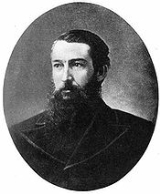
music
ian and poet
.
Sidney Lanier was born February 3, 1842, in Macon
, Georgia
, to parents Robert Sampson Lanier and Mary Jane Anderson; he was mostly of English ancestry. His distant French Huguenot ancestors immigrated to England
in the 16th century fleeing religious persecution. He began playing the flute
at an early age, and his love of that musical instrument
continued throughout his life.
And yet shall Love himself be heard,Though long deferred, though long deferred:O'er the modern waste a dove hath whirred:Music is Love in search of a word.![]()
Virginal shy lights,Wrought of the leaves to allure to the whisper of vows,When lovers pace timidly down through the green colonnadesOf the dim sweet woods, of the dear dark woods,Of the heavenly woods and glades,That run to the radiant marginal sand-beach withinThe wide sea-marshes of Glynn.![]()
The sun is a-wait at the ponderous gate of the West.![]()
Ye marshes, how candid and simple and nothing-withholding and freeYe publish yourselves to the sky and offer yourselves to the sea!Tolerant plains, that suffer the sea and the rains and the sun,Ye spread and span like the catholic man who hath mightily wonGod out of knowledge and good out of infinite painAnd sight out of blindness and purity out of a stain.![]()
The incalculable Up-and-Down of Time.![]()

